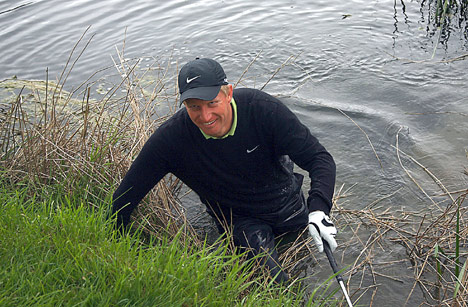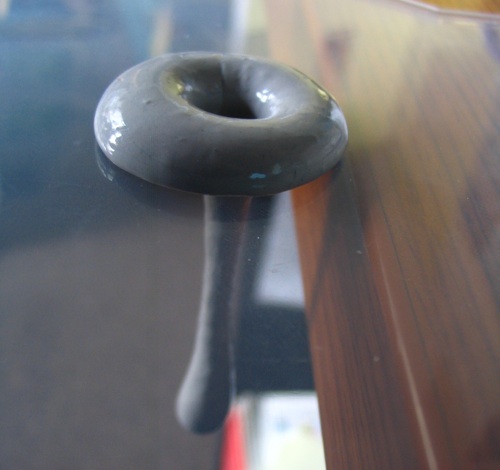You don't understand. You can't just come to the Sea of Galilee and start walking on water. If you could, everybody would be doing it. You need to prepare yourself. -Walk on Water
As some of you may have noticed from looking at the site over the past few days, Scienceblogs has partnered with National Geographic. To celebrate this, I want to show you one of my favorite National Geographic clips of all time, showcasing the Central American Basilisk. (Its nickname? "The Jesus Lizard.") Why? You'll see...

Of course, we're not. But you're familiar with water acting like a solid, even if you don't know it. What would happen if you jumped out of an airplane and your parachute didn't open? Would landing over a lake be any better for you than landing on dry land?

Of course not; on an extreme enough timescale, any fluid can act like a solid, and any solid can act like a liquid! Don't believe it? Take some silly putty, roll it into a ball, and throw it against a wall. It'll bounce, acting like a solid! Now take that ball of silly putty, and put it on a flat surface with a hole in it. And wait a few minutes. You should start to see it act like a liquid, like this.

Physicists call materials that are in-between solids and liquids like this non-Newtonian fluids. They are some of the most fun you can have, if you can get enough of them. My personal favorite? Cornstarch + water. What can you do with enough of it? Remember the basilisk?

Even more like a solid, if you ball up 50 lbs of Silly Putty and throw it off the roof it shatters.
What a delightful little Lizard! It doesn't match the Gecko in raw coolness, but still damn cool!
hey, that lizard is *running* on water, not walking.
Walking on water isn't that hard--I've done it myself.
Step 1: Wait for the pond to freeze over.
Falling on water without a parachute... That is one ugly bellyflop I don't want to be in.
I always thought the pitch drop experiment was/is cool: http://www.smp.uq.edu.au/pitch/
The stained glass in midieval churches is flowing, albeit very slowly. I've always thought that was kind of amazing.
Don't forget glass! Glass from the early days of American colonization is noticeably thicker at the bottom than at the top because it is slowly oozing downwards under the force of gravity.
Aw, PGE beat me to it. Frowny face.
That old glass exhibits flow is a common misconception:
http://en.wikipedia.org/wiki/Glass#Behavior_of_antique_glass
So the other day I saw an episode of the British car show Top Gear, in which some icelandic off-road racers decided to see if their big snow-tired four wheelers, driven fast enough, could stay on top of a lake. They did. Then they raced against a snowmobile. The snowmobile won. You seriously do not want a wet spark plug or transmission failure or whatever when doing that!
I read somewhere that a pane of glass may get a fraction of an inch thicker at the bottom over several million years. At the least I think it's much more than a couple hundred....
@Jim Bob Cooter: That may be an urban myth. The plate glass may have been cast to be thicker on the one edge. There is a glass flow experiment somewhere; it's pretty clever because it's measuring the bending of a glass rod rather than the flow. I have no idea what the results are to date. I think Rob J might have got it right though. When you're below the glass transition temperature, glass is pretty immobile.
Didn't the Myth Busters do a show with the corn starch + water?
As for just plain old water; for ballistics tests you can take a pistol or rifle (up to about 0.30 caliber) and simply fire into a trough about 4m long. That's sufficient to slow down all small arms fire so that the slug barely nudges the other end of the trough. With a muzzle velocity of 200 to over 300m/s, that's quite an impressive deceleration. Imagine the shape you'd be in if you were flying a jet at that speed and stopped in 4m - sound solid enough?
YOU'RE an urban myth.
@13: "Didn't the Myth Busters do a show with the corn starch + water?"
yes they did. It was a buoyancy myth. IIRC it was busted.
@12:
All the original old window panes in old English houses that I have seen, including one I owned that dated to 1720, were thicker at the bottom enough to show visible artefacts when you looked through them. I doubt very much that the builders deliberately aligned all their wedge-shaped pieces of glass the same way. Or that their glass started off wedge-shaped. Another side effect was a tendency to separate from the frame at the top edge. Could be a frame problem but it sure looked like the glass was withdrawing, not the frame distorting.
Glass manufacturing techniques have matured rapidly over the last couple of centuries. It is very likely that today's glass is far less susceptible to creep.
Anybody here have fun with Prince Rupert Drops at High School? You might have to be old enough for the safety mavens to have not yet noticed them. But I'm old enough that not only were they demonstrated to us, we made and broke our own. There are a few You-Tube videos of them. Very visceral demonstration of a super cooled fluid in metastable equilibrium under pressure.
For the glass flowing myth, see separate discussions in:
http://en.wikipedia.org/wiki/Glass
http://math.ucr.edu/home/baez/physics/General/Glass/glass.html
http://www.glassnotes.com/WindowPanes.html
Old glass panes typically severely distorted the view; this is even described in some detail by Marcel Minnaert in "The nature of light and colour in the open air". Modern plate glass has far better tolerance on the dimensions and fewer striae. Even with modern plate glass, if you have a good look through your window (or even car windscreen) you will see non-uniformities in thickness and the occasional bubble or string of bubbles.
Glass Flowing Myth: Busted
@Gray Gaffer: I think I know what you're talking about; for me it was Saint Vitus' Tears. Get a nice blob of molten glass, quench in a bucket, whack with a hammer, then pinch with some tweezers?
i heard from a physics prof that although glass is a liquid, and flows, it doesn't flow fast enough for windows to get thicker on the bottom in any human time scale. the reason that old houses have thicker glass on the bottom is because they were deliberately installed that way. the glass is thicker on one side than the other due to the manufacturing process in the olden days. the glass paner dude simply put the panes in thick side down.
of course i heard it a while ago and i have no references. i could be mistaken. plus you *are* reading this on the internet...
I found some articles (including the Wikipedia) which state that glass doesn't flow and why they say that. Unfortunately the comment is held for moderation (due to the links). But the short story is that the myth of flowing glass is busted - many times over by different people. Of course when glass is heated above the glass transition temperature it does flow, but that's a no-brainer.
@#3, rob:
It's a hard call, but I disagree. Looking closely at the video, I think Ethan's original description is correct: the lizard is walking (one foot always in contact with the ground/water) and not running (no contact with the ground/water at times).
What's especially interesting about the walking/running distinction here is that this lizard seems to have developed a leg motion specifically designed to enable it to walk at high speed.
This may be getting too technical, but in normal bipedal or quadrupedal walking - in which the body passes over a straightened leg - there is a maximum walking speed: the speed at which gravity doesn't supply enough centripetal force (as the body rotates over the ankle pivot) to maintain contact with the ground. Above this speed you "fly off" the ground, and running begins.
The lizard here has a walking motion (with bent legs, and without the body "over" the legs) specifically designed to avoid this problem. Groucho Marx's walk would a similar technique for humans. Such techniques are not allowed in Olympic Walking competition specifically because they enable walking at higher speed.
@ MadScientist - Saint Vitus' Tears? Yes, the process is the same, never heard it called that though. Gotta be real careful between quenching and breaking off the tail. Like a hand grenade with the pin pulled during that time. What the lizard is doing we might have called St Vitus' Dance, however.
I had a science teacher in HS who believed in what he called "Bucket Chemistry". None of those piddling little 5 ml test tubes for him, no sir! Had to be a litre or more. We did the drops in Chem not Physics because it was in chem we learned glass blowing, for making instruments. Making the drops was his way of getting us to understand the dynamics of hot glass. The kids today are really missing out on lots of fun on the edge! Mercury hearts. Ether flows downhill. Conc Nitric Acid burns holes in your notebook (and turns fingers brown). Hydrogen needs 1/2 m Oxygen to explode. Nitrogen Tri-Iodide paste (did we pour Hydro-Chloric acid over it first?). Sodium boats. We had a good time.
They really did lay the glass thick side down? Is there a reason for the wedge shape then? Helps somehow in setting the glass before the putty is pressed over it? The glass guy who help me renovate my cottage didn't know, and of course the new glass was flat. The old stuff may have had romantic connotations, but as that reality show about living Victorian pointed out, the old days were not so good, really. I had to start from dirt floors and poor power and plumbing. Never again!
Here's a salute to our favorite fluidishness:
https://www.google.com/reader/view/?tab=my#stream/feed%2Fhttp%3A%2F%2Fw…
Oops, I meant this one:
http://www.thinkin-lincoln.com/index.php?strip_id=616
I knew as soon as I got partway into this post that the glass discussion was sure to follow.
There are some good links above, but the bottom line is this: glass absolutely does not flow like a liquidânot only not in human timescales, but even on inhuman timescales. The very quick and irrefutable counter-argument against claims of cathedral windows and the like are glass figurines from the Roman era, which are much, much older than cathedral windows and yet are undistorted.
Prior to the 20th century, window glass was made by spinning the molten glass, causing panes to be thicker in one direction than the other.
Much confusion on this issue is caused by conflation of terminology and physical characteristics. "Liquid" is an imprecise term and has different meanings in different technical disciplines. A physicist, for example, uses the term both most exactly and most generally. To a physicist, glass is, in fact, a "liquid"...but then, so is pretty much everything that isn't a regular crystalline solid, a gas, or a plasma. This includes things like, say, rocks. Clearly, a physicist's definition of "liquid" is not the most appropriate to use for this discussion.
The scientist most equipped to discuss states of matter in a useful and descriptive way that means something in this context to a layperson would probably be a materials scientist. And, to a materials scientist, glass is most certainly not a liquid, but rather a special class of solids called "amorphous solids". And they don't necessarily flow on anything less than cosmic timescales, either (though they can).
However, because by some definitions glass is a "liquid"; and because someone, somewhere, got the idea that glass then flows like a liquid; and especially because someone noticed that often old window glass is thicker at the bottom than at the top...well, this false comprehension gained a life of its own. Not just in the popular imagination, but more perniciously in schoolrooms and college classrooms and from out of the mouths of respected teachers and professors and even into textbooks.
It almost seems immortal, but my observation of just the last twenty years seems to indicate that the debunking is very slowly beginning to overtake the myth.
Old English glass was spun in a disk, so that there was always a thick end towards the centre, and a thin end near the edge. The most expensive glass was the stuff near the edge, since it caused less viewing distortion. The cheaper glass towards the centre was used by poorer dwellings, and always laid thick end down.